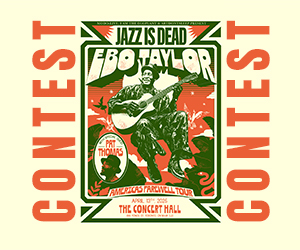BEHIND THE GALLERY: NINE INCH NAILS
A CONVERSATION WITH PHOTOGRAPHER JONATHAN RACH
In a dimly lit gallery in Los Angeles, the thunderous energy of Nine Inch Nails’ Self-Destruct Tour was reawakened through a series of raw, emotionally charged photographs by Jonathan Rach. For over two decades, these images lived unseen in a box—until a chance encounter with Steven, the founder of Behind the Gallery, sparked an international exhibit that has since traveled from Melbourne to Tokyo, London to LA, and now possibly, to Toronto.
The origins of this exhibit are as organic as the photos themselves, when founder and creative director Steve Dallimore came across his work online. “Steven saw some prints I had put online and asked if I had more,” Rach explains. “I told him I had hundreds, and I shared the story behind them. He was intrigued, put a proposal together, and I ran it by Trent [Reznor] to make sure he was on board. And he was.”
The collection, shot during Nine Inch Nails’ infamous mid-90s Self-Destruct Tour, is more than just a series of concert snapshots; it’s an emotional arc captured on film. “At the time, I was choosing the images with raw energy in mind,” Rach recalls. “But years later, I started looking for pictures that told a broader emotional story. These shows were either chaotic and rage-filled, tearing down the status quo, or they were sparse and somber. I tried to select images that captured that full spectrum.”
Rach didn’t just focus on the intensity of the performances. He made a point to include quiet moments too, specifically dressing room shots where band members looked utterly depleted. “They had given everything on stage. I wanted to be true to that.”
What makes Behind the Gallery’s presentation of these works stand out is its immersive, fan-forward curation. “Most traditional galleries focus on Dylan, The Beatles, Hendrix,” Rach notes. “Steven was one of the first to embrace ‘90s icons like Nine Inch Nails, years before the rest caught on. Plus, he played the actual music in the gallery. Since the whole exhibit was centered around one tour, you could use that album as the exhibit’s literal soundtrack.”
The exhibition, often hosted in unconventional pop-up locations, goes far beyond static photo viewing. It’s become a community event. “Trent loved that fans would come out and actually meet each other,” Rach says. “It wasn’t just social media anymore. People drove hours, even flew in. Some asked if they could just hang out every day. Of course, we said yes.”
The images themselves are striking for their imperfections. Shot in the pre-digital era, Rach had no luxury of previews or Photoshop. “You’d take a photo and not see it for a week and a half,” he laughs. “There was no control over lighting, no control over the subject. You had to capture the right moment in a split second or miss it forever.”
One such moment became iconic: a blurry, emotionally resonant photo of Reznor kicking a keyboard. “It’s not perfect,” Rach admits. “But it feels like that tour. It’s magic. I don’t even remember taking it. That’s how I know it’s special.”
Before he ever picked up a camera for the tour, Rach was initially brought on to design the stage, then asked to document the experience through film. A suggestion from legendary photographer Anton Corbijn led him to grab a still camera, and the rest is history. “I had access most photographers dream of,” he says. “It was just the band, a bodyguard, the tour manager, and me for two and a half years. We became family.”
That experience, and those photos, changed the course of his creative career. “Everything I learned from Nine Inch Nails carried into my later work,” he says, referencing collaborations with artists like David Bowie, Tool, and A Perfect Circle. “But I also learned I never want to go on a two-and-a-half-year tour again. That was intense.”
While no gallery date is confirmed yet, Toronto might be the next stop. “We get a lot of requests from cities like Toronto, Chicago, San Francisco, and Mexico City,” Rach says. “If you know some good pop-up spaces, let us know. We’d love to bring it there.”
And for all the years Rach spent living like a rock star behind the lens, the most meaningful part of his journey has been the human connections. “It’s always the friendships,” he reflects. “Getting to be that close to artists like Trent and Bowie, seeing what they go through; it’s rare. But this exhibit, and the kindness from fans, has been deeply humbling. Photographers don’t usually get this kind of recognition. It’s been unreal.”
From the lens of a stage designer-turned-documentarian-turned-photographer, Jonathan Rach has gifted the world an emotionally layered visual time capsule—one that doesn’t just capture a band, but a moment in music history that refuses to fade.




























